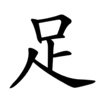足
| ||||||||
| ||||||||
Translingual
| Stroke order | |||
|---|---|---|---|
 | |||
Alternative forms
- 𧾷 (when used as a left radical)
Han character
足 (Kangxi radical 157, 足+0, 7 strokes, cangjie input 口卜人 (RYO), four-corner 60801, composition ⿱口龰)
- Kangxi radical #157, ⾜.
- Shuowen Jiezi radical №40
Derived characters
References
- KangXi: page 1221, character 17
- Dai Kanwa Jiten: character 37365
- Dae Jaweon: page 1692, character 29
- Hanyu Da Zidian (first edition): volume 6, page 3686, character 1
- Unihan data for U+8DB3
Chinese
| simp. and trad. |
足 | |
|---|---|---|
| alternative forms | 𠯁 𠯣 | |
Glyph origin
| Historical forms of the character 足 | |
|---|---|
| Western Zhou | Shuowen Jiezi (compiled in Han) |
| Bronze inscriptions | Small seal script |
 |
 |
Etymology 1
Uncertain. Compare Proto-Mon-Khmer *ɟuŋ ~ *ɟuəŋ ~ *ɟəŋ (“leg, foot”), whence Mon ဇိုၚ် (cf. Schuessler, 2007).
Pronunciation
Definitions
足
Synonyms
- (foot):
Dialectal synonyms of 腳 (“foot”) [map]
- (football):
Dialectal synonyms of 足球 (“football; soccer”) [map]
Compounds
Derived terms from 足
|
|
|
Etymology 2
Probably Sino-Tibetan; compare Tibetan ཆོག (chog, “to be sufficient”) (Coblin, 1986).
Pronunciation
Definitions
足
Synonyms
- (to be worthy of):
- (very):
Dialectal synonyms of 很 (“very”) [map]
Etymology 3
From etymology 2, with *-s (“causative, outwardly directed action”) (Schuessler, 2007; Baxter and Sagart, 2014).
Pronunciation
Compounds
|
Japanese
Readings
Compounds
Compounds
- 足掻き (agaki): pawing
- 足跡 (ashiato): footprint
- 足音 (ashioto): sound of footsteps
- 足掛かり (ashigakari): foothold
- 足首 (ashikubi): ankle
- 足取り (ashidori): gait, trace
- 足白癬 (ashihakusen): athlete's foot
- 足早 (ashibaya): briskness, swift-footedness, fast-pacedness
- 足元 (ashimoto): near or at one's feet
- 足袋 (tabi): tabi
- 豚足 (tonsoku): pig's trotters
Etymology 1
| Kanji in this term |
|---|
| 足 |
| あし Grade: 1 |
| kun’yomi |
| For pronunciation and definitions of 足 – see the following entry. | ||
| ||
| (This term, 足, is an alternative spelling of the above term.) |
Etymology 2
| Kanji in this term |
|---|
| 足 |
| そく Grade: 1 |
| on’yomi |
Pronunciation
- IPA(key): [so̞kɯ̟ᵝ]
Korean
Etymology
From Middle Chinese 足 (MC t͡sɨok̚).
| Historical Readings | ||
|---|---|---|
| Dongguk Jeongun Reading | ||
| Dongguk Jeongun, 1448 | 죡〮 (Yale: cyók) | |
| Middle Korean | ||
| Text | Eumhun | |
| Gloss (hun) | Reading | |
| Hunmong Jahoe, 1527 | 발〮 (Yale: pál) | 죡〮 (Yale: cyók) |
Pronunciation
- (SK Standard/Seoul) IPA(key): [t͡ɕo̞k̚]
- Phonetic hangul: [족]
Compounds
Compounds
- 족쇄 (足鎖, jokswae)
- 족의 (足衣, jogui)
- 족장 (足掌, jokjang)
- 족적 (足迹, jokjeok)
- 족지 (足指, jokji)
- 족지 (足趾, jokji)
- 족하 (足下, jokha)
- 구족 (具足, gujok)
- 금족 (禁足, geumjok)
- 기족 (驥足, gijok)
- 만족 (滿足, manjok)
- 발족 (發足, baljok)
- 보족 (補足, bojok)
- 부족 (不足, bujok)
- 사족 (四足, sajok)
- 사족 (蛇足, sajok)
- 선족 (跣足, seonjok)
- 섬족 (贍足, seomjok)
- 수족 (手足, sujok)
- 실족 (失足, siljok)
- 염족 (饜足, yeomjok)
- 요족 (饒足, yojok)
- 월족 (刖足, woljok)
- 의족 (義足, uijok)
- 일족 (逸足, iljok)
- 장족 (長足, jangjok)
- 정족 (鼎足, jeongjok)
- 주족 (馵足, jujok)
- 준족 (駿足, junjok)
- 지족 (知足, jijok)
- 질족 (疾足, jiljok)
- 충족 (充足, chungjok)
- 탁족 (濯足, takjok)
- 흡족 (洽足, heupjok)
- 삼족오 (三足烏, samjogo)
- 정족수 (定足數, jeongjoksu)
- 과부족 (過不足, gwabujok)
Okinawan
Kanji
足
Compounds
- 寝んじ不足 (ninjibusuku, “lack of sleep, sleep deprivation”)
Pronunciation
- IPA(key): /ɸisa/
Derived terms
- 足甲 (fisanā, “top of the foot”)
Pronunciation
- IPA(key): /ʔaɕi/
Noun
足 (hiragana あし, rōmaji ashi, historical hiragana わし, rōmaji washi)
- edible leg (of a pig, etc)
- (only in compounds) foot
Derived terms
- 足てぃびち (ashitibichi, “pig's feet soup”)
References
- 1896: 沖縄語典 (Okinawa Goten, “Okinawan Dictionary”). In Japanese. http://kindai.ndl.go.jp/info:ndljp/pid/992016/13
Vietnamese
Han character
足: Hán Nôm readings: túc
- This term needs a translation to English. Please help out and add a translation, then remove the text
{{rfdef}}.
This article is issued from Wiktionary. The text is licensed under Creative Commons - Attribution - Sharealike. Additional terms may apply for the media files.